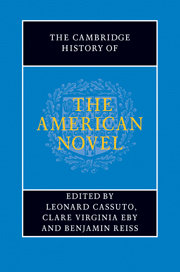Book contents
- Frontmatter
- General Introduction
- PART ONE INVENTING THE AMERICAN NOVEL
- PART TWO REALISM, PROTEST, ACCOMMODATION
- Introduction: realism, protest, accommodation
- 17 Realism and radicalism: the school of Howells
- 18 James, pragmatism, and the realist ideal
- 19 Theories of the American novel in the age of realism
- 20 The novel in postbellum print culture
- 21 Twain, class, and the Gilded Age
- 22 Dreiser and the city
- 23 Novels of civic protest
- 24 Novels of American business, industry, and consumerism
- 25 New Americans and the immigrant novel
- 26 Cather and the regional imagination
- 27 Wharton, marriage, and the New Woman
- 28 The postbellum race novel
- 29 The African American novel after Reconstruction
- 30 The rise of naturalism
- 31 Imagining the frontier
- 32 Imperialism, Orientalism, and empire
- 33 The hemispheric novel in the post-revolutionary era
- 34 The woman's novel beyond sentimentalism
- 35 Dime novels and the rise of mass-market genres
- 36 Readers and reading groups
- PART THREE MODERNISM AND BEYOND
- PART FOUR CONTEMPORARY FORMATIONS
- A selected bibliography
- Index
19 - Theories of the American novel in the age of realism
from PART TWO - REALISM, PROTEST, ACCOMMODATION
Published online by Cambridge University Press: 28 July 2011
- Frontmatter
- General Introduction
- PART ONE INVENTING THE AMERICAN NOVEL
- PART TWO REALISM, PROTEST, ACCOMMODATION
- Introduction: realism, protest, accommodation
- 17 Realism and radicalism: the school of Howells
- 18 James, pragmatism, and the realist ideal
- 19 Theories of the American novel in the age of realism
- 20 The novel in postbellum print culture
- 21 Twain, class, and the Gilded Age
- 22 Dreiser and the city
- 23 Novels of civic protest
- 24 Novels of American business, industry, and consumerism
- 25 New Americans and the immigrant novel
- 26 Cather and the regional imagination
- 27 Wharton, marriage, and the New Woman
- 28 The postbellum race novel
- 29 The African American novel after Reconstruction
- 30 The rise of naturalism
- 31 Imagining the frontier
- 32 Imperialism, Orientalism, and empire
- 33 The hemispheric novel in the post-revolutionary era
- 34 The woman's novel beyond sentimentalism
- 35 Dime novels and the rise of mass-market genres
- 36 Readers and reading groups
- PART THREE MODERNISM AND BEYOND
- PART FOUR CONTEMPORARY FORMATIONS
- A selected bibliography
- Index
Summary
The novel gained unprecedented prestige in the age of realism. The chief ground of opposition to the upstart form had largely been contained by mid-century – moralistic alarm at its alleged powers of seduction. But only after 1865 did the dream of “the great American novel” displace the dream of a national epic. Fiction, declared William Dean Howells at century's end, had become “the chief intellectual stimulus of our time, whether we like the fact or not.” “To-day is the day of the novel,” Frank Norris agreed. Posterity has confirmed the verdict. No span of US literary history before or since has been defined so predominantly in terms of its prose fiction.
Fiction theory lagged behind practice. In 1884, Henry James could call “The Art of Fiction” an almost untouched topic. “Only a short time ago,” in the days of Dickens and Thackeray, the English novel “had no air of having a theory, a conviction, a consciousness of itself behind it,” as if “a novel is a novel, as a pudding is a pudding,” and “our only business with it could be to swallow it.” The situation soon improved considerably. Important American writers published such notable critical books as Howells's Criticism and Fiction (1891), Hamlin Garland's Crumbling Idols (1894), and Edith Wharton's The Art of Fiction (1925). James raised the genre of the authorial preface to a plane of unequaled sophistication. Close reading reached its first maturity between James's Hawthorne (1879) and William Crary Brownell's American Prose Masters (1909). The first histories of American literature date from the postbellum period, the first critical handbooks from the early twentieth century.
- Type
- Chapter
- Information
- The Cambridge History of the American Novel , pp. 322 - 336Publisher: Cambridge University PressPrint publication year: 2011
- 1
- Cited by



